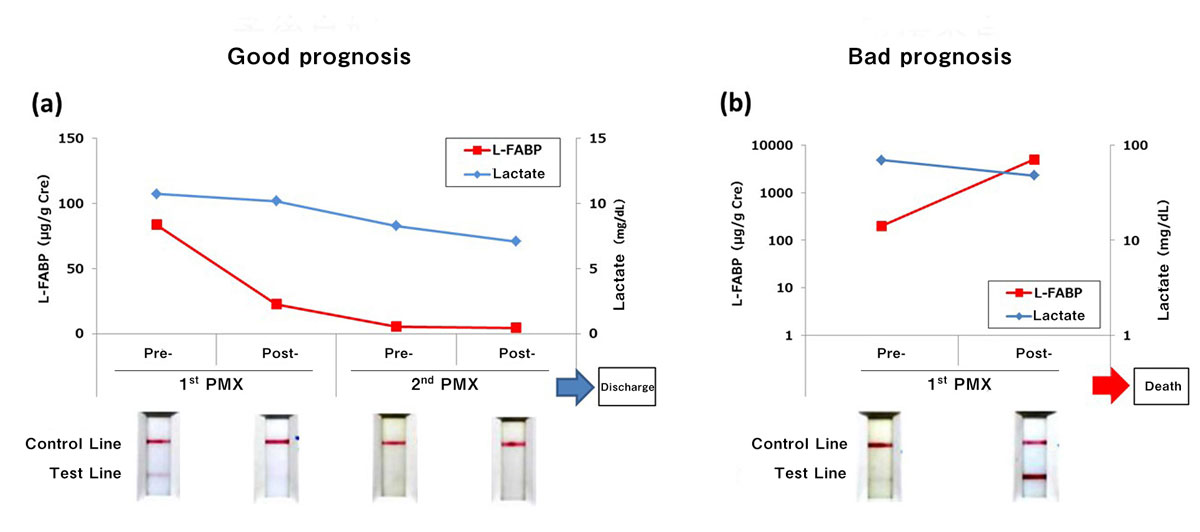Key word: Sepsis, POC (Point of Care)
Tendency and prognosis of blood lactic acid and urinary L-FABP levels in sepsis patients treated by PMX

Click to enlarge image
Partially modified from Fig.8 of [1]
Method
(a) 93-year-old woman with septic shock induced by iliopsoas abscess, received 2 PMX interventions.
(b) 75-year-old woman with septic shock induced by acute obstructive suppurative cholangitis, received 1 PMX intervention.
Results and discussions
After PMX interventions, the patient (a) who has both urinary L-FABP and lactic acid levels decreased, was discharged from hospital. However, the patient (b) who has not, died 3 days after intervention.
From these results, urinary L-FABP level measurement in sepsis patients could deduct the severity of sepsis and evaluate therapeutic efficacy of intervention.
Sepsis is defined as a serious condition resulting the malfunctioning of various organs induced by the infection. It induces multiple organ failure including acute kidney injury (AKI) and the mortality is high especially in severe cases. There are several indicators of infection disease diagnosis such as the SOFA (sequential (sepsis-related) organ failure assessment), qSOFA (quick sepsis-related organ failure assessment) as organ damages indicators, and the CRP (C-reactive protein), PCT (procalcitonin), P-SEP (presepsin) and IL-6 (interleukine-6) as sepsis diagnosis markers. However, the evaluation of P-SEP or PCT are only weakly recommended in The Japanese Clinical Practice Guidelines for Management of Sepsis and Septic Shock 2016, when sepsis is suspected in critically ill patients at ICU. So the biomarker which is able to specify quickly, accurately and simply severity degree of sepsis and to determine appropriately which treatment should be performed to patient, is required. In several clinical studies show the increase of urinary L-FABP level in sepsis patients and its level decreased after treatment.[1-4]
References
- [1] Sato, E. et al., Urinary excretion of liver-type fatty acid-binding protein reflects the severity of sepsis. Renal Replacement Therapy. 3(26), 2017. https://rrtjournal.biomedcentral.com/articles/10.1186/s41100-017-0107-x
- [2] Sato, R., et al., A newly developed kit for the measurement of urinary liver-type fatty acid-binding protein as a biomarker for acute kidney injury in patients with critical care. J Infect Chemother. 21(3):165-169, 2015. PubMed
- [3] Doi, K., et al., Urinary L-type fatty acid-binding protein as a new biomarker of sepsis complicated with acute kidney injury. Crit Care Med. 38(10):2037-2042, 2010. PubMed
- [4] Yoshimatsu, S., et al., Urinary L-FABP as a mortality predictor in <5-year-old children with sepsis in Bangladesh. Pediatr Int. 58(3):185-191, 2016. PubMed